Quantification of the Morphological Signature of Roping Based on Multiscale Analysis and Autocorrelation Function Description
Abstract
:1. Introduction
- -
- To assess the differences of predictions made by different models. Wu et al. [5] used a finite element method incorporating measured Electron Back Scattered Diffraction (EBSD) data to simulate the development of roping. They analyzed the changes in the surface profiles to compare different predictions.
- -
- To measure the influence of grain size and shape on roping level. Patra et al. [6] examined the microstructure changes at different steps of the industrial process of 409 L grade ferritic stainless steel and identified a direct correlation between roping and the severity of coarse-grain banding.
- -
- To assess the influence of iron contents on roping phenomenon, Jin and Lloyd [7] investigated the impact of Fe contents on roping. In their study, the examined the evolution of roughness through the use of the arithmetical mean height Ra and total height of the profile Rt but they did not link the roping level (qualitative estimation of roping) with the roughness results.
2. Materials and Methods
2.1. Material and Roughness Measurements
- -
- for the multiscale analysis, 100 measurements of 1188 µm × 891 µm with a step of 1.09 µm were performed on each specimen with a 20× objective (I 200646, Zygo Corp, Middlefield, CT, USA). An example of measurement is shown in Figure 1.
- -
- for the autocorrelation function description, two very large measurements of 84,385 µm × 17,691 µm were performed on each specimen with a 5× objective (CF Plan 427028, Nikon, Tokyo, Japan) (and 0.5× zoom).
2.2. Multiscale Analysis Methodology
3. Results and Discussion
3.1. Multiscale Analysis
- (i)
- a correlation between a tested roughness parameter and the five levels of roping, hereafter called ‘gradation description’,
- (ii)
- a correlation between a roughness parameter values and the acceptable or non-acceptable status of the specimens, hereafter called ‘binary description’.
3.2. Description based on the Autocorrelation Function
3.2.1. Regularity Parameter
3.2.2. Quantitative Description of Roping based on the Autocorrelation Function
4. Conclusions
Author Contributions
Funding
Conflicts of Interest
References
- Sinclair, C.W. Embedded Grain Rotation and Roping of Stainless Steel. Metall. Mater. Trans. A 2007, 38, 2435–2441. [Google Scholar] [CrossRef]
- Ma, X.; Zhao, J.; Du, W.; Zhang, X.; Jiang, L.; Jiang, Z. Quantification of texture-induced ridging in ferritic stainless steels 430 and 430LR during tensile deformation. J. Mater. Res. Technol. 2019, 8, 2041–2051. [Google Scholar] [CrossRef]
- Kusters, S.; Seefeldt, M.; Van Houtte, P. A Fourier image analysis technique to quantify the banding behavior of surface texture components in AA6xxx aluminum sheet. Mater. Sci. Eng. A 2010, 527, 6239–6243. [Google Scholar] [CrossRef]
- Qin, L.; Seefeldt, M.; Van Houtte, P. Analysis of roping of aluminum sheet materials based on the meso-scale moving window approach. Acta Mater. 2015, 84, 215–228. [Google Scholar] [CrossRef]
- Wu, P.D.; Lloyd, D.J.; Bosland, A.; Jin, H.; MacEwen, S.R. Analysis of roping in AA6111 automotive sheet. Acta Mater. 2003, 51, 1945–1957. [Google Scholar] [CrossRef]
- Patra, S.; Ghosh, A.; Sood, J.; Singhal, L.K.; Podder, A.S.; Chakrabarti, D. Effect of coarse grain band on the ridging severity of 409L ferritic stainless steel. Mater. Des. 2016, 106, 336–348. [Google Scholar] [CrossRef]
- Jin, H.; Lloyd, D.J. Roping in 6111 aluminum alloys with various iron contents. Mater. Sci. Eng. A 2005, 403, 112–119. [Google Scholar] [CrossRef]
- Shi, Y.; Jin, H.; Wu, P.D.; Lloyd, D.J. Analysis of roping in an AA6111 T4P automotive sheet in 3D deformation states. Acta Mater. 2017, 124, 598–607. [Google Scholar] [CrossRef]
- Engler, O.; Schäfer, C.; Brinkman, H.J. Crystal-plasticity simulation of the correlation of microtexture and roping in AA 6xxx Al–Mg–Si sheet alloys for automotive applications. Acta Mater. 2012, 60, 5217–5232. [Google Scholar] [CrossRef]
- Shin, H.-J.; An, J.-K.; Park, S.H.; Lee, D.N. The effect of texture on ridging of ferritic stainless steel. Acta Mater. 2003, 51, 4693–4706. [Google Scholar] [CrossRef]
- Ma, X.; Zhao, J.; Du, W.; Zhang, X.; Jiang, Z. Effects of rolling processes on ridging generation of ferritic stainless steel. Mater. Charact. 2018, 137, 201–211. [Google Scholar] [CrossRef]
- Lee, M.H.; Kim, R.; Park, J.H. Effect of nitrogen on grain growth and formability of Ti-stabilized ferritic stainless steels. Sci. Rep. 2019, 9, 1–11. [Google Scholar] [CrossRef] [PubMed]
- Baczynski, G.J.; Guzzo, R.; Ball, M.D.; Lloyd, D.J. Development of roping in an aluminum automotive alloy AA6111. Acta Mater. 2000, 48, 3361–3376. [Google Scholar] [CrossRef]
- Zhang, C.; Liu, Z.; Wang, G. Effects of hot rolled shear bands on formability and surface ridging of an ultra purified 21%Cr ferritic stainless steel. J. Mater. Process. Technol. 2011, 211, 1051–1059. [Google Scholar] [CrossRef]
- Cai, Y.; Wang, X.; Yuan, S. Analysis of surface roughening behavior of 6063 aluminum alloy by tensile testing of a trapezoidal uniaxial specimen. Mater. Sci. Eng. A 2016, 672, 184–193. [Google Scholar] [CrossRef]
- Cai, Y.; Wang, X.; Yuan, S. Surface Roughening Behavior of 6063 Aluminum Alloy during Bulging by Spun Tubes. Materials (Basel). 2017, 10, 299. [Google Scholar] [CrossRef] [Green Version]
- Lefebvre, G.; Sinclair, C.W.; Lebensohn, R.A.; Mithieux, J.-D. Accounting for local interactions in the prediction of roping of ferritic stainless steel sheets. Model. Simul. Mater. Sci. Eng. 2012, 20, 024008. [Google Scholar] [CrossRef]
- Choi, Y.S.; Piehler, H.R.; Rollett, A.D. Introduction and application of modified surface roughness parameters based on the topographical distributions of peaks and valleys. Mater. Charact. 2007, 58, 901–908. [Google Scholar] [CrossRef]
- Guillotin, A.; Guiglionda, G.; Maurice, C.; Driver, J.H. Quantification of roping intensity on aluminium sheets by Areal Power Spectral Density analysis. Mater. Charact. 2010, 61, 1119–1125. [Google Scholar] [CrossRef]
- Stoudt, M.R.; Hubbard, J.B. Analysis of deformation-induced surface morphologies in steel sheet. Acta Mater. 2005, 53, 4293–4304. [Google Scholar] [CrossRef]
- Bigerelle, M.; Najjar, D.; Mathia, T.; Iost, A.; Coorevits, T.; Anselme, K. An expert system to characterise the surfaces morphological properties according to their tribological functionalities: The relevance of a pair of roughness parameters. Tribol. Int. 2013, 59, 190–202. [Google Scholar] [CrossRef] [Green Version]
- Takechi, H.; Kato, H.; Sunami, T.; Nakayama, T. The Mechanism of Ridging Formation in 17%-Chromium Stainless Steel Sheets. Trans. Jap. Inst. Met. 1967, 8, 233–239. [Google Scholar] [CrossRef] [Green Version]
- Wright, R.M. Anisotropic Plastic Flow in Ferritic stainless steels and the “roping” phenomenon. Met. Trans. 1972, 3, 83–91. [Google Scholar] [CrossRef]
- ISO-ISO 16610-49:2015–Geometrical Product Specification (GPS) – Filtration–Part 49: Morphological Profile Filters: Scale Space Techniques. ISO: Geneva, Switzerland. Available online: https://www.iso.org/standard/61381 (accessed on 10 March 2020).
- Stout, K.J.; Matthia, T.; Sullivan, P.J.; Dong, W.P.; Mainsah, E.; Luo, N.; Zahouani, H. The Developments of Methods for the Characterisation of Roughness in Three Dimensions; Office for Official Publications of the European Communities: Luxembourg, 1993. [Google Scholar]
- ISO-ISO 25178-1:2016–Geometrical Product Specifications (GPS)–Surface Texture: Areal–Part 1: Indication of Surface Texture. ISO: Geneva, Switzerland. Available online: https://www.iso.org/standard/46065.html (accessed on 7 July 2020).
- Guillemot, G.; Bigerelle, M.; Khawaja, Z. 3D parameter to quantify the anisotropy measurement of periodic structures on rough surfaces. Scanning 2014, 36, 127–133. [Google Scholar] [CrossRef]

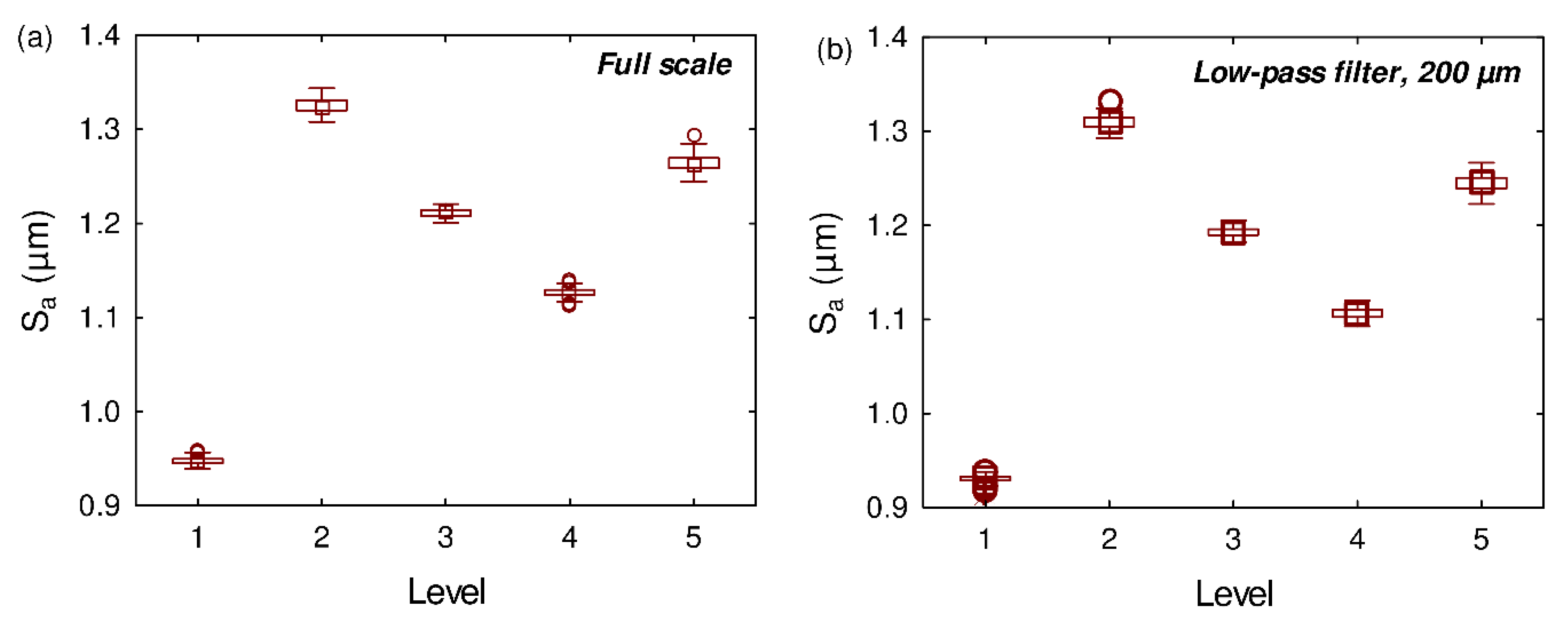
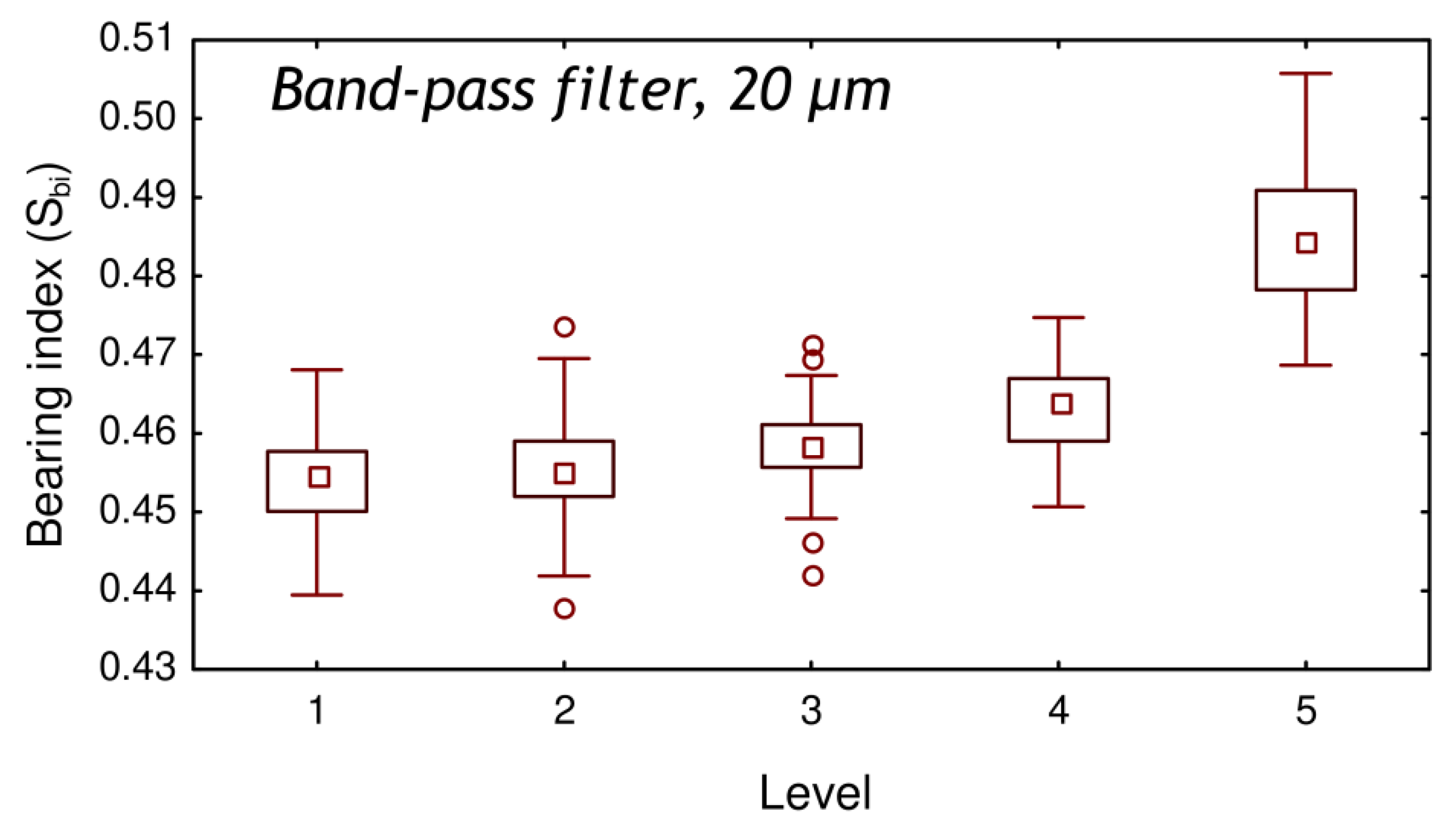
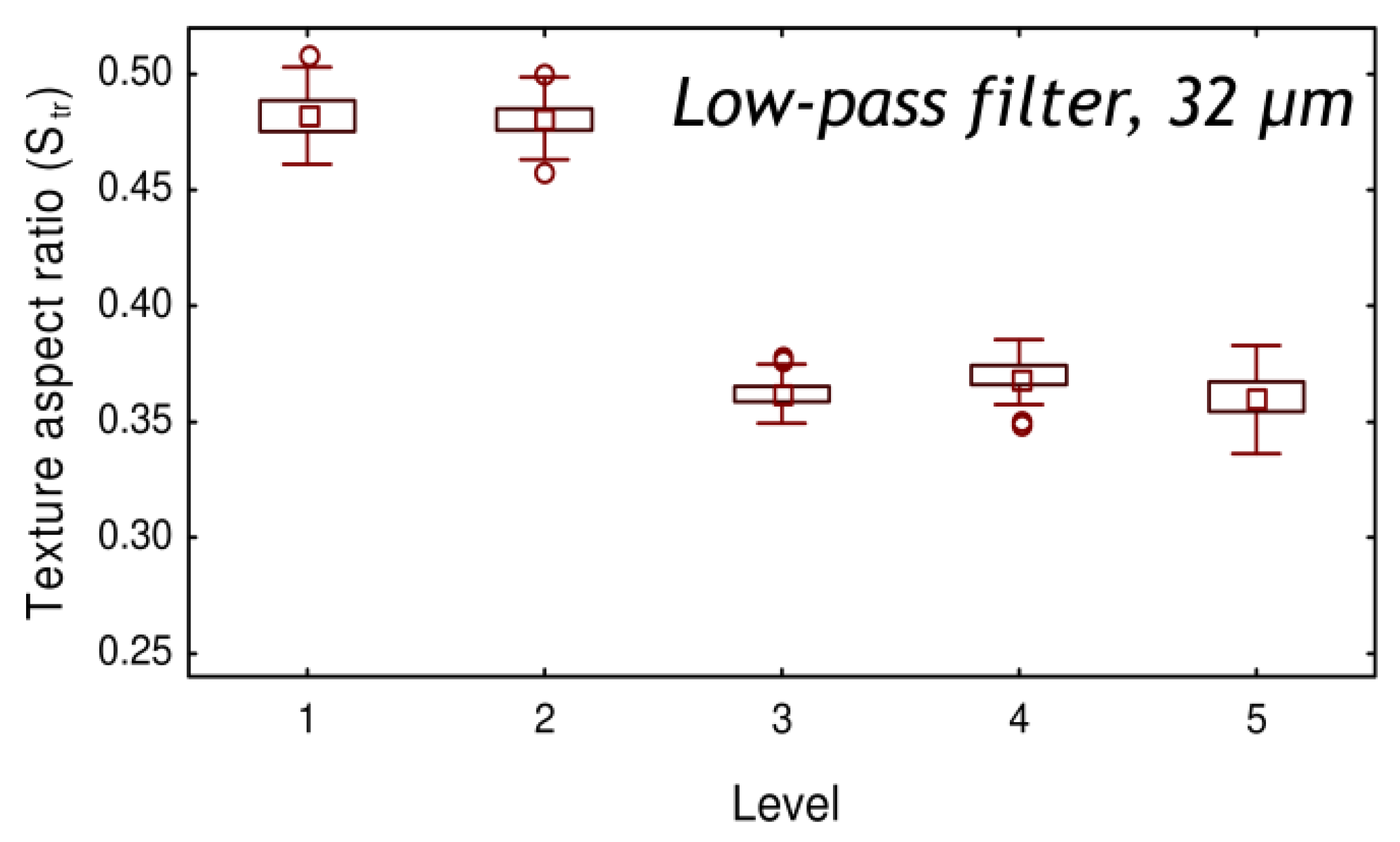
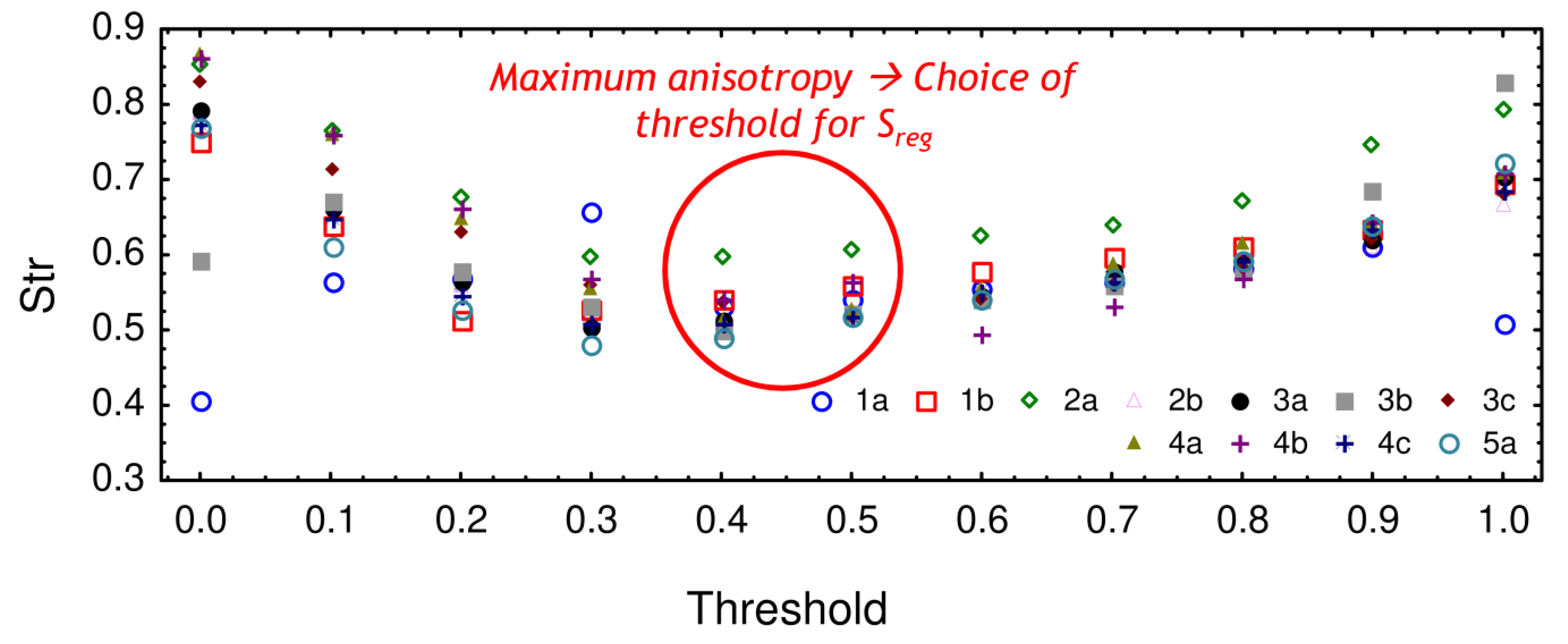



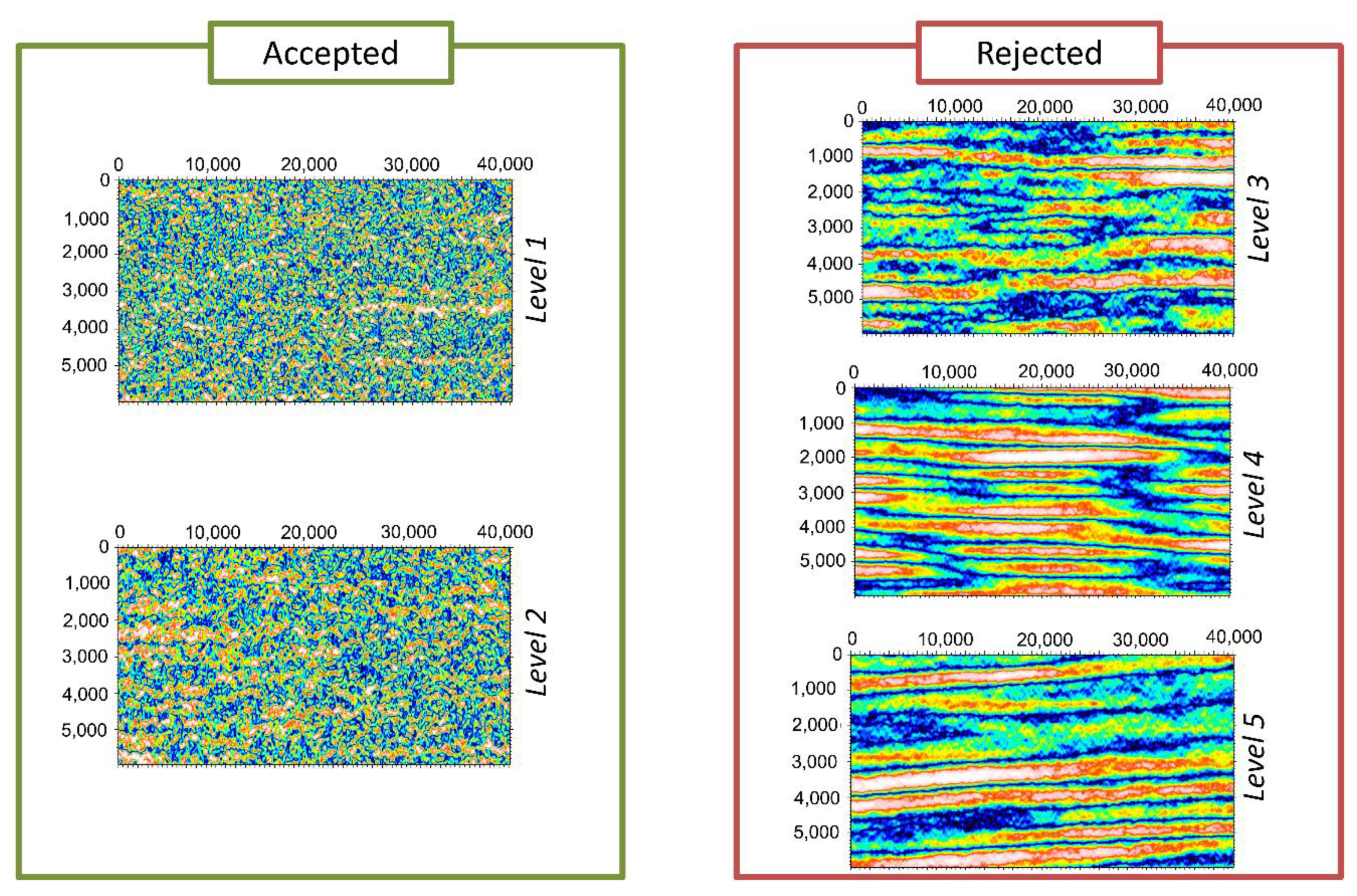
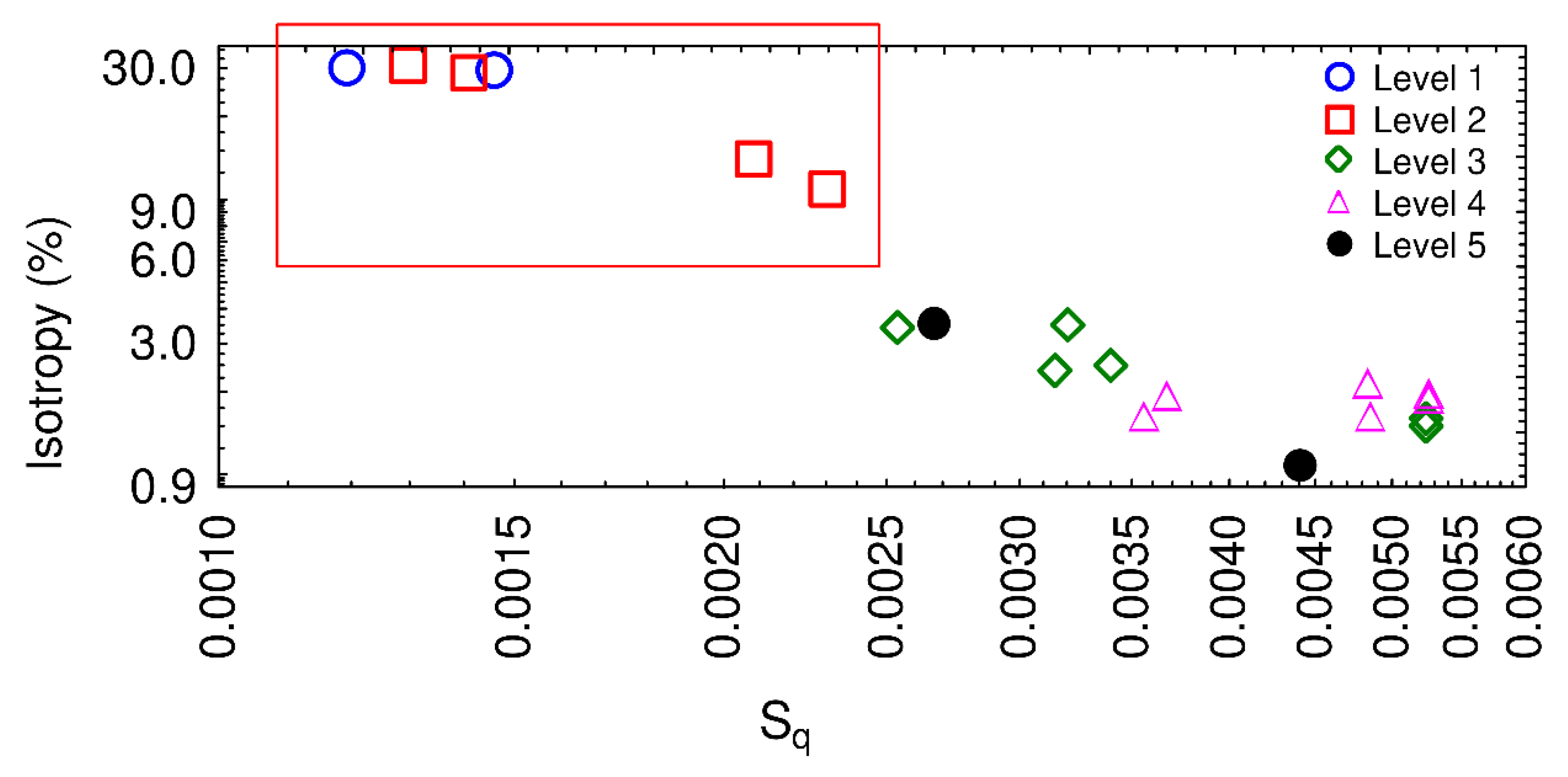
| Level 1 | Level 2 | Level 3 | Level 4 | Level 5 |
|---|---|---|---|---|
| 2 | 2 | 3 | 3 | 1 |
© 2020 by the authors. Licensee MDPI, Basel, Switzerland. This article is an open access article distributed under the terms and conditions of the Creative Commons Attribution (CC BY) license (http://creativecommons.org/licenses/by/4.0/).
Share and Cite
Marteau, J.; Deltombe, R.; Bigerelle, M. Quantification of the Morphological Signature of Roping Based on Multiscale Analysis and Autocorrelation Function Description. Materials 2020, 13, 3040. https://doi.org/10.3390/ma13133040
Marteau J, Deltombe R, Bigerelle M. Quantification of the Morphological Signature of Roping Based on Multiscale Analysis and Autocorrelation Function Description. Materials. 2020; 13(13):3040. https://doi.org/10.3390/ma13133040
Chicago/Turabian StyleMarteau, Julie, Raphaël Deltombe, and Maxence Bigerelle. 2020. "Quantification of the Morphological Signature of Roping Based on Multiscale Analysis and Autocorrelation Function Description" Materials 13, no. 13: 3040. https://doi.org/10.3390/ma13133040






